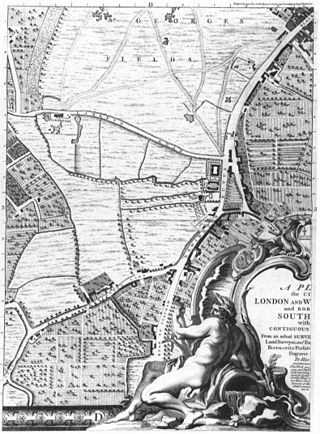
Southwark is a district of Central London situated on the south bank of the River Thames, forming the north-western part of the wider modern London Borough of Southwark. The district, which is the oldest part of South London, developed due to its position at the southern end of the early versions of London Bridge, for centuries the only dry crossing on the river. Around 43 AD, engineers of the Roman Empire found the geographic features of the south bank suitable for the placement and construction of the first bridge.

The London Borough of Southwark in South London forms part of Inner London and is connected by bridges across the River Thames to the City of London and London Borough of Tower Hamlets. It was created in 1965 when three smaller council areas amalgamated under the London Government Act 1963. All districts of the area are within the London postal district. It is governed by Southwark London Borough Council.

Little Dorrit is a novel by Charles Dickens, originally published in serial form between 1855 and 1857. The story features Amy Dorrit, youngest child of her family, born and raised in the Marshalsea prison for debtors in London. Arthur Clennam encounters her after returning home from a 20-year absence, ready to begin his life anew.

Borough High Street is a road in Southwark, London, running south-west from London Bridge, forming part of the A3 route which runs from London to Portsmouth, on the south coast of England.
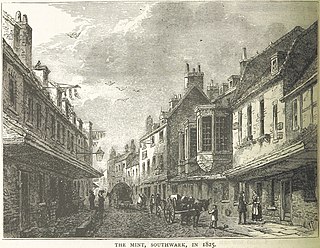
The Mint was a district in Southwark, south London, England, on the west side of Borough High Street, around where Marshalsea Road is now located. It was so named because a mint authorised by King Henry VIII was set up in Suffolk Place, a mansion house, in about 1543. The mint ceased to operate in the reign of Mary I and Suffolk Place was demolished in 1557. In the late-17th and early-18th centuries, the area was known for offering protection against prosecution for debtors due to its legal status as a "liberty", or a jurisdictional interzone.
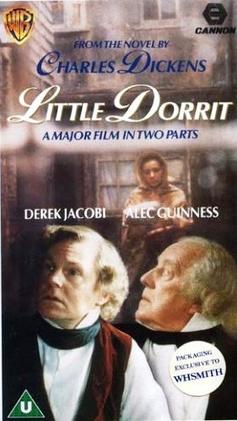
Little Dorrit is a 1987 film adaptation of the 1857 novel Little Dorrit by Charles Dickens. It was written and directed by Christine Edzard, and produced by John Brabourne and Richard B. Goodwin. The music by Giuseppe Verdi was arranged by Michael Sanvoisin.

St George the Martyr is a church in the historic Borough district of south London. It lies within the modern-day London Borough of Southwark, on Borough High Street at the junction with Long Lane, Marshalsea Road, and Tabard Street. St George the Martyr is named after Saint George. The church is a Grade II* listed building.
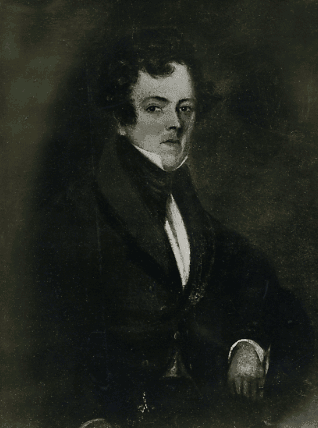
John Dickens was the father of famous English novelist Charles Dickens and was the model for Mr Micawber in his son's semi-autobiographical novel David Copperfield.

Union Street is a major street in the London Borough of Southwark. It runs between Blackfriars Road to the west and Borough High Street to the east. Southwark Bridge Road crosses in the middle.
Horsemonger Lane Gaol was a prison close to present-day Newington Causeway in Southwark, south London. Built at the end of the 18th century, it was in use until 1878.

The King's Bench Prison was a prison in Southwark, south London, England, from medieval times until it closed in 1880. It took its name from the King's Bench court of law in which cases of defamation, bankruptcy and other misdemeanours were heard; as such, the prison was often used as a debtor's prison until the practice was abolished in the 1860s. In 1842, it was renamed the Queen's Bench Prison, and became the Southwark Convict Prison in 1872.

The Marshalsea (1373–1842) was a notorious prison in Southwark, just south of the River Thames. Although it housed a variety of prisoners—including men accused of crimes at sea and political figures charged with sedition—it became known, in particular, for its incarceration of the poorest of London's debtors. Over half of England's prisoners in the 18th century were in jail because of debt.
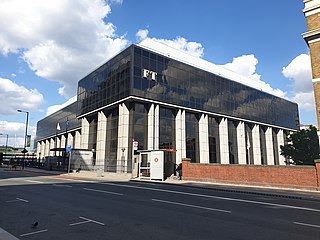
Southwark St Saviour was a civil parish in the metropolitan area of London, England, and part of the ancient Borough of Southwark. It was formed in 1541 from the union of the parishes of St Margaret and St Mary. It was abolished in 1930, however residents of the former parish receive a rebate against local taxation because of the presence of Borough Market. It included the Liberty of the Clink which was a special jurisdiction until 1889.
The King's Manor - formally 'The City of London's King's Manor of the Town and Borough of Southwark' - is an institution of the City of London which is not a Livery Company as it is territorially rather than trade based, being the organisation of the Juror freemen of the Court Leet. The Manor covers the area from the western-side of Borough High Street, Southwark, to the borders of Newington and Lambeth. The manor originally lay in Surrey.

Lant Street is a street south of Marshalsea Road in Southwark, south London, England.

Little Dorrit's Playground, named after Little Dorrit, the eponymous Charles Dickens character, is a public playground and small park just north of Marshalsea Road in Southwark, south London, England.

Long Lane is a main east–west road in Southwark, south London, England.

Charles Dickens's works are especially associated with London, which is the setting for many of his novels. These works do not just use London as a backdrop but are about the city and its character.
This is a list of the etymology of street names in the London district of Southwark. The area has no formally defined boundaries – those utilised here are: the river Thames to the north, Tower Bridge Road to the east, Bricklayers Arms/New Kent Road/Elephant and Castle to the south, and London Road/St George's Circus/Blackfriars Road to the west.







